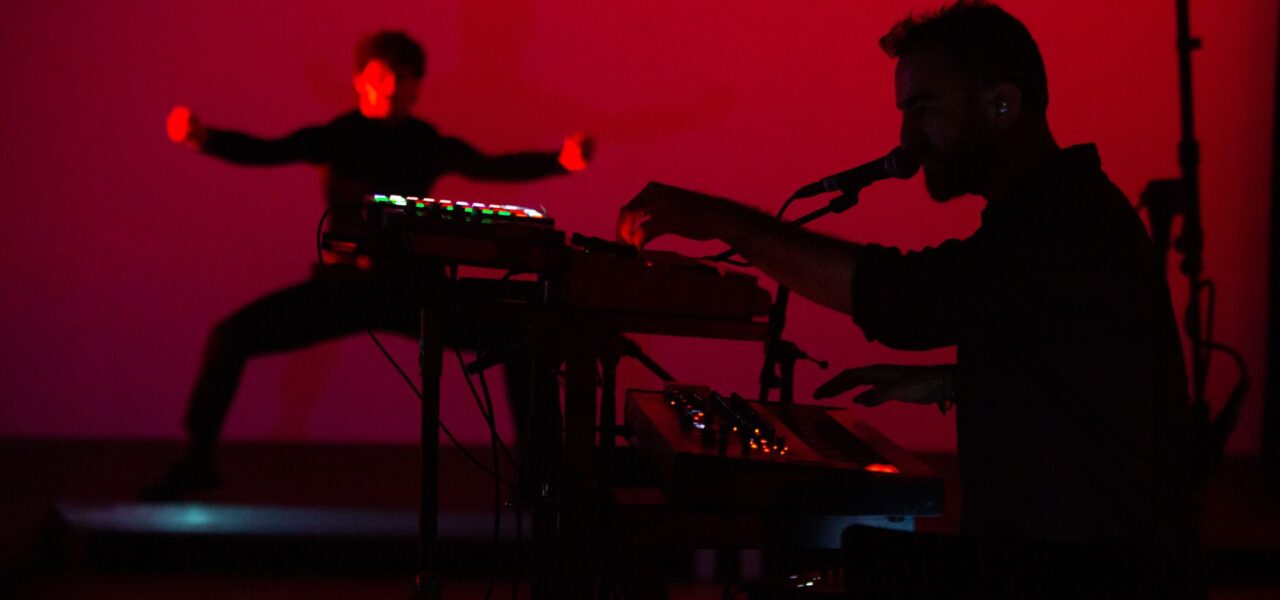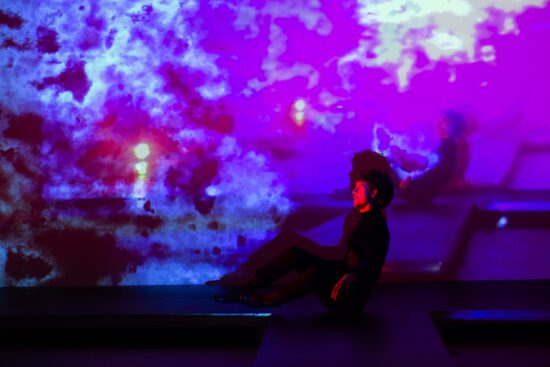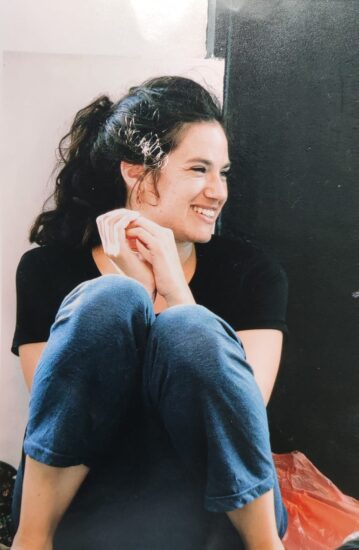‘Machine Plays Man’ by Eden Kramer- המכונה מנגנת על האדם’ מאת עדן קרמר’

צילום: דפנה טלמון
‘המכונה מנגנת על האדם’ מאת גיא מוזס חוקרת את גבולות האלתור באמצעות שחקן מפתיע, AI.
הרדמתי את הילד, לבשתי שמלה ויצאתי לת”א תרבות דה-וינצ’י, בית לתרבות מקומית (מקום מעניין, משופץ היטב, כמעט נקי מדי, שבאמת רואים את הכוונה שלו לתמוך באמנות חדשה בעיר. אהבתי.), לראות ניסוי בימתי כנראה הראשון מסוגו פה בארץ: אילתור רב-תחומי בשילוב בינה מלאכותית. כל מי שאילתרה אי פעם יודעת שבאימפרוביזציה המגבלה היא החברה הטובה ביותר של היצירתיות. הנחייה סגורה מדי חונקת את הדמיון והנחייה פתוחה מדי היא פרוצה, מובילה לחיפוש כללי שהרבה פעמים נראה מקושקש. יש איזה קו קסום באמצע בו הנחייה ספציפית משרטטת זירה, הופכת להיות מנוע של חומרים.
הפרפורמנס הרב תחומי “המכונה מנגנת על האדם” מאת גיא מוזס (גילוי נאות: אני נשואה לו) חוקר את גבולות האלתור באמצעות שחקן מפתיע, קלוד, העוזר האישי הלא הוא AI שפרץ לחיינו לאחרונה בשלל תחומים. אני למשל ניסיתי לתת לו לסכם לי מאמרים אקדמיים והוא עשה זאת בבינוניות מדשדשת, אבל דווקא במופע הזה הוא עשה עבודה מצוינת. בכל אופן, אומרים שעדכון הגרסא הבאה הוא צפוי להשתפר.
הקהל נכנס אל תוך חלל שמורכב מ-4 עמדות, אחת לכל פרפורמר: המתופף אור האגר על התופים, גיא מוזס בעמדת הקלידים-סינתים-אפקטים, אמנית הוידאו דניאל פרסאי מקרינה על קיר שלרגליו ניצבת במה בצורת T שהיא הזירה של הרקדן עירד אבני.
חוקי המשחק ברורים: המכונה מגרילה בכל פעם הנחייה אחת מתוך בנק שהיא הכינה מראש, קוראת אותה בקול, מגדירה זמן לתרגיל ופותחת שעון עצר שסופר לאחור. הפרפורמרים מגיבים מייד, צריכים לייצר על המקום את הפרשנות שלהם ביחס למה שביקשה המכונה כשהם נשענים על הדמיון, המיומנות, וזה על זה.
התוצאה היא טיול בין עולמות. לפעמים התרגיל מתייחס קונקרטית לאלמנט כמו מהירות או עוצמה (תתחילו חלש ותסיימו בשיא הכוח), לפעמים הוא שואב השראה מיצירות אייקוניות (בעקבות המיתוס של סיזיפוס, חזרו על אותה פעולה שוב ושוב) ולפעמים הוא מבקש מהשחקנים בקשות מופרכות כמו לתאר חרק שלא קיים. הקהל הסתקרן לראות את ההתמודדות של הרביעייה עם הבקשות שחלקן עוררו צחוק וחלקן התניעו צלילה עמוקה. ואכן, למרות שזאת היתה עבודת משך במסגרת אירוע מלא התרחשויות, והקהל מוזמן היה להיכנס ולצאת כרצונו, היו לא מעט אנשים שנשארו בחדר שעתיים ויותר.
בתוך מרחב אימפרוביזציה שכזה יש גם רגעים של חיפוש, רגעים פחות ברורים של נפילת אנרגיה וחוסר עניין, אבל הרביעייה המוצלחת ידעה לחלץ את עצמה מכל בור כזה ולהגיע שוב ושוב אל רגעי הרמוניה. המנגנון עצמו בנוי כך שהוא נותן מדי פעם מנוחה לאחד או שניים מהפרפורמרים, למשל, מנחה קטע אילתור של רקדן ומתופף בלבד, או קטע שהוא רק מוסיקלי. כך לפעמים יכול היה כל אחד לקבל הפוגה ולאגור כוחות לסיבוב הבא, והקהל יכול היה לחוות רגעים פחות עמוסים במידע הזורם אל כל החושים בבת אחת. אפשר היה להתייחס לכל פרפורמר כערוץ בפני עצמו, כלומר, ליהנות מהאלמנט החזותי או מהצלילים או מהתנועה בנפרד ולהתבונן בשילובים ביניהם כשכבות שנאספות אל תוך תמונות שנוצרו פעמים רבות במקריות ולאו דווקא בכוונה תחילה. אבל הרגעים החזקים ביותר היו אלה שבהם כולם פעלו יחד ואפשר היה לחוש בהקשבה הגבוהה ביניהם, שבשיא שלה הפיקה רטט חד פעמי שלכד את מי שנמצא בחדר.
מי שתפס את העין רוב הזמן היה עירד. החוזקה שלו כרקדן היא הטוטאליות שלו, ההתמסרות המוחלטת לכל פעולה. רואים את המחויבות בכל תא ותא בגופו, והמסירות הזאת, יחד עם תעוזה בימתית, מתעלות על כל יכולת טכנית. כבר בתרגיל השלישי או הרביעי לתוך הערב הוא פירק אחד מחלקי המסלול וסחב אותו על גבו הלוך ושוב, יוצר מופע שבו באמת הכל יכול לקרות ומשאיר את הצופים עירניים ודרוכים למתרחש. הוידאו החי החמיא לו כשהוקרנו עליו שכבות של צבע שיצרו צלליות שכמו הכפילו את דמותו והמוסיקה החיה עטפה אותו והפעילה אותו מבפנים. הוא היפנט את הקהל והחזיק – בסיבולת נעורים מרשימה שאפשר רק לקנא בה – מופע אילתור ארוך שהיה למעשה סולו אחד ארוך, מחולק לפרקים.
האם הוא פעל מתוך ההנחייה, מתוך קשב למוסיקה שעטפה אותו, מתוך הצבעים והצורות שהוקרנו בחלל, או שכל אלו היו רק נקודת פתיחה לאילתור שעיקרו הוא בעצם הקשבה פנימה, לגוף? אי אפשר לדעת, וזה לא משנה. בסופו של דבר הוא החזיק, בכריזמה רבה, יותר משעתיים של אילתור. אתגר גדול לכל הדעות.
יצאתי עם הערכה גדולה למלאכת האילתור ועם מחשבות על שילוב בינה מלאכותית בתוך מופע חי. האם ההנחיות של המכונה יכלו להיכתב בידי אדם? התשובה היא כן. האם אדם היה מנסח אותן טוב יותר, מהר יותר, עם יותר מעוף? לא בטוח בכלל. זאת היתה הפעם הראשונה בה נכחתי באירוע לייב שמשלב טכנולוגיית בינה מלאכותית. נראה שעצם השילוב עורר סקרנות ומשך קהל, שהרי כבר ברור לכולם שצ’ט GPT ודומיו עתידים להשפיע על כל תחומי החיים, וכנראה בקרוב מאוד, רק שלא לגמרי ברור איך.
בכל אופן, כצופה מהצד הידיעה ש-AI היה מעורב במופע לא ממש שינתה לי את החוויה. אולי בעתיד, כשקלוד (אני מדמיינת אותו עם שפם) יוכל באמצעות טכנולוגיית מצלמה ושמע באמת “לנכוח” בחלל, לייצר על המקום הנחיות ותרגילים חדשים בהתאם למידע שהוא קולט מהחדר, להגיב בזמן אמת, הוא ישנה את עולם המופע ללא היכר. אני יכולה לדמיין מצב שבו קלוד לא רק מנחה את הפרפורמרים אלא מעצב את חוויית הצפייה של הקהל בזמן אמת (עכשיו שכבו על הגב ועצמו עיניים, עכשיו אפשר להסתובב חופשי בחלל שבין המופיעים וכו’). בשלב הבא, קלוד אולי יוכל ליצור בעצמו מוסיקה חיה או וידאו-ארט חי, כלומר, לאלתר באופן עצמוני ודיגיטלי. האפשרות הזאת מפחידה. מה שבטוח זה שבינתיים הוא לא מסוגל להחליף את ההנאה האסתטית-אנושית מצפייה בגופים אמיתיים שמחזיקים כלים אמיתיים עשויים חומר אמיתי, מנגנים, רוקדים, מזיעים, מביטים, נושמים.
חזרתי הביתה לילד ושמחתי שיש עוד שטחים בחיים בהם לא הכל ידוע, לא הכל מפוענח, לא הכל נגיש לנו תוך שניות.

צילום: דפנה טלמון
‘Machine Plays Man’ by Guy Moses explores the boundaries of improvisation using a surprising actor, AI.
I put my kid to sleep, put on a dress and went out to Tel Aviv Culture Da Vinci, a home for local culture (an intriguing place, well-renovated, almost too clean, in which one can really see the desire to support new art in the city. I like it.) I went out to see a staged experiment that is perhaps the first of its kind here in Israel: multi-disciplinary improvisation combined with artificial intelligence.
Anyone who has improvised knows that, in improvisation, limitation is creativity’s best friend. Overly narrow direction can suffocate the imagine and overly wide instruction can lead to unguided searching, which often appears pointless. There is this magical middle ground in which specific prompts define an arena, becoming an engine for generating material.
The multi-disciplinary performance ‘Machine Plays Man’ by Guy Moses (disclosure: I am married to him) explores the boundaries of improvisation using a surprising actor, Claude, the personal assistant AI that has entered our lives lately in a variety of fields. I, for example, asked him to summarize some academic essays and he did it with astounding mediocrity however, in this performance, he did great work. In any case, they say the new operating system will improve him.
The audience enters into a space made of four stations, one for each performer: drummer Or Hager, Guy Moses on the keyboard-synth-effects, video artist Danielle Parsay projecting on one wall at the foot of which is a T-shaped stage, which is the domain of dancer Irad Avni.
The rules of the game are clear: the machine draws one prompt from a pre-determined bank each time, reads it out loud and sets a time limit for the exercise, displaying a countdown. The performers respond immediately, creating their response to what the machine has said in real time using imagination and skill.
The result is a tour through different worlds. Sometimes the exercise relates to a concrete element like speed or force (start softly and end in at peak strength), sometimes it draws inspiration from iconic creations (inspired by Sisyphus, repeat the same action over and over) and sometimes it asks the players inane requests like describing a bug that doesn’t exist. The audience was curious to see the quartet cope with the requests, some evoking laughter while others allowed for a deep dive. As such, although this was a durational performance in an evening packed with events, and the audience were invited to come and go as they pleased, there were many people who stayed in the room for two hours if not more.
In an improvisation space like this one there are moments of searching, moments of unclarity, energetic drops and loss of interest but this talented foursome knew how to get out of each dip, time and again reaching harmony. The mechanism is built as such that each performer gets a break once in a while. For example, there was a section of the dancer and the drummer only, or another that was just music. In that way, each one had the chance to rest and gather strength for the next round while the audience experienced moments that were less intense and packed with information. Each performer could be viewed as their own channel; one could enjoy the visual element or the music or the movement alone or watch the combinations between them that were happening by chance. The strongest moments were those in which all four were active together and the audience could witness the awareness and listening they had amongst them, a type of wavelength that, at its climax, created a type of vibration that embraced everyone in the room.
The person who caught my eye most of the time was Irad. His strength as a dancer is in his totality, his readiness to commit to each action. One can see his dedication in each and every cell in his body, that submission, together with performative boldness, which overpower any technical abilities. Already in the third or fourth exercise of the evening he dismantled a part of the stage and carried it on his back to and fro creating a reality in which anything could happen and leaving the audience on the edge of their seat. The live video complimented him as it was projected onto his body while the live music encompassed him and drove him from within. He hypnotized the audience and maintained- with youthful endurance that can only be coveted- a lengthy, one-man, improvised performance broken into parts.
Did he act out the prompts, listening to the music around him, within the colors and shapes projected on him or were each of these just an entry point to an improvisation motivated by inner voices? It’s impossible to know and it doesn’t matter. In the end, he held it together, with great charisma, over the course of more than two hours of improvisation. An unquestionable challenge.
I left the event with a great appreciation for the art of improvisation and with thoughts about the integration of AI in live performance. Could the prompts have been written by a person? The answer is yes. Would a person have written them better, quicker or with more vision? Not for sure. It was the first time I was present in a live event using AI technology. It seems the mere fact of the experiment aroused curiosity and drew in audience. After all, it is clear to us all that ChatGPT and its buddies are going to influence all fields, seemingly very soon, we just don’t know exactly how.
In any case, as a viewer, the knowledge that AI was part of the show didn’t really change my experience. Perhaps in the future, when Claude (I imagine him with a moustache) can use sound and video technologies to be “present” in the space and can create directions and exercises based on information he gathers from the room, reacting in real time, he will alter the world of performance to its core. I can imagine a situation in which Claude not only directs the performers rather designs the audience experience in real time (now lie on your back and close your eyes, now you can wander freely through the space, etc.). In the next phase, Claude might be able to compose his own music or create video art. Maybe he will be able to improvise digitally. That possibility is terrifying. What is certain is that for now, he is not able to replace the aesthetic-human enjoyment of watching real bodies using real tools made of real material playing, dancing, sweating, looking and breathing.
I returned home to my child and I was happy there are still areas in life in which not everything is known, not everything is decoded, not everything is available within seconds.
עדן קרמר היא פרפורמרית, יוצרת, עורכת טקסט וסטודנטית לתואר שני באמנויות באוניברסיטת תל אביב. 
